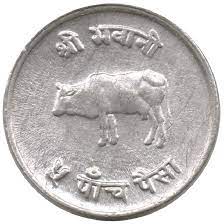Introduction:
Nepalese coins serve as subtle reminders of the country’s complex past, capturing the political, social, and cultural shifts that have molded the area throughout the ages. The development of Nepalese currency reveals a complex tapestry of creative expression, dynastic transitions, and economic adjustments spanning from ancient city-states to the contemporary Federal Democratic Republic. This thorough study aims to explore the rich universe of Nepalese coins, encompassing a range of kingdoms and historical periods, in order to reveal the narratives inscribed on these little but important pieces of money.
Ancient Coins: Tracing the Roots
Nepal’s history with coins dates back to antiquity, when coinage first began in the Licchavi era, which began in the fifth century. This era’s coins, which were mostly made of copper and silver, had images of monarchs, animals, and gods on them. These ancient coins were essential to regional trade and commerce because they provided a medium of exchange. Despite having a simple design, the Licchavi coins served as the impetus for a centuries-long numismatic legacy.
Medieval Period: The Malla Marvels
Strong kingdoms came to power in the medieval era, chiefly the Mallas, who had a lasting impact on Nepal’s monetary system. The Malla rulers, who ruled over several territories, produced coins with elaborate patterns on them. These coins, which included regal portraits, religious emblems, and mythical themes, demonstrated the marriage of creative expression with metallurgical skill. Aesthetic sensibilities and a wealth of culture are best shown in the Malla coins, which are frequently crafted from a variety of metals.
The Shah Dynasty: Unification and Transformation
A significant turning point in the history of the country occurred when King Prithvi Narayan Shah united Nepal in the 18th century. A new era of coinage began with the rise of the Shah dynasty. The monarch’s name, royal titles, and symbols denoting the union of many states were all included on the early Shah coins. Hindu cultural influences may be seen in the emblems chosen, which included the lotus and the trident. The Shah coins contributed to maintaining the unity of the recently established kingdom in addition to acting as a means of commerce.


British Influence: Numismatic Crossroads
The growing influence of the British on the Indian subcontinent throughout the 19th century resulted in notable changes to the currency landscape of Nepal. The East India Company’s influence led to the coinage’s blend of traditional Nepalese and British design features. This blending is best shown by the Gorkha coins from this era, which display a variety of cultural influences that reflected the geopolitical climate of the day. The complex interactions between indigenous and colonial powers are reflected in the coins struck during this period of numismatic crossroads.
Modern Era: Evolution in Design and Ideology
Nepal’s coinage system had significant changes over the 20th century, reflecting the country’s changing political climate. Coins changed in style and philosophy from the time of the Kingdom of Nepal to the Federal Democratic Republic’s founding. The coinage shows how monarchy gave way to republicanism, with national symbols and emblems honoring Nepal’s rich cultural past replacing royal images. The nation’s welcoming character is reflected in the designs of contemporary coins, which celebrate the diversity of its cultures, faiths, and customs.
Cultural Significance: Beyond Currency
Nepalese coins represent more than just monetary trade; they have cultural and religious importance. Coins with Buddhist symbols, Hindu deities, and famous places highlight the country’s rich spiritual and cultural diversity. Every penny turns into a little canvas on which historical events, myths, and tales of devotion are depicted. These coins’ fine features serve as a cultural archive that links the past and present in addition to showcasing the minters’ creative skill.
Challenges and Innovations: Adapting to Modern Realities
Despite having a long history, Nepalese coins have not been exempt from the difficulties of the contemporary world. Traditional coinage is facing increasing difficulties due to counterfeiting, shifting economic dynamics, and the emergence of digital currencies. To preserve the integrity of the money, the authorities have, nonetheless, reacted resolutely, implementing cutting-edge security measures and creative designs. The adaptability of the Nepalese currency system demonstrates a dedication to both accepting technology improvements and maintaining the historical tradition.


Conclusion: Unveiling the Tapestry of Nepalese Numismatics
To sum up, the exploration of Nepalese coins unveils an enthralling mosaic of legacy, customs, and tenacity. Every coin narrates the tale of a country in transition, from the simple yet meaningful Licchavi coins to the elaborate designs of the Malla rulers and the revolutionary Shah dynasty. This story is further enhanced by the contemporary republic and the British-influenced past, which demonstrate how flexible Nepal’s monetary system is. It is clear from examining the inventions, difficulties, and cultural importance that Nepalese coins represent more than just money; they are symbols of a country’s identity that embrace the past while looking to the future.




